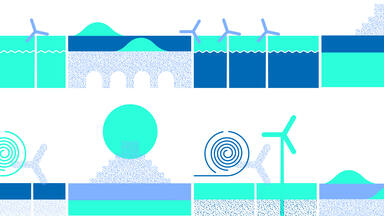Case Study: Policy framework for a controlled wind energy development near a transboundary World Heritage property
Germany, Denmark, Netherlands / Wadden Sea
The transboundary World Heritage property is managed according to the trilaterally adopted Wadden Sea Plan (WSP), a common framework for the protection and sustainable management of the Wadden Sea as an ecological entity. The Nature Conservation Area in Germany/Schleswig-Holstein is nearly 100% identical to the Word Heritage property. The WSP was adopted in 2010, and a single integrated management plan for the property, as a complementary tool, has recently been elaborated.
The plans refer to the increasing energy production in the Wadden Sea Region, both onshore and offshore and its several possible side-effects including growing ship traffic in the coastal sea and air pollution, as well as cable crossing through the conservation area and interference with bird flyways and areas used by marine mammals. These activities are covered in the respective Target chapters. All activities likely to have a significant effect on the Wadden Sea ecosystem, either individually or in combination with other plans or projects, are subject to licensing following an impact assessment in accordance with the stipulations of the Habitats Directive.
With regards to wind energy development, the WSP prohibits the erection of wind farms within the property (designated under spatial planning law). The construction of wind turbines in the Wadden Sea Area outside or adjacent to the Nature Conservation Area and World Heritage property is only allowed, if important ecological and landscape values are not negatively affected.
State Party:
Germany, Denmark, Netherlands
World Heritage property:
Wadden Sea
Criteria:
(viii)(ix)(x)
Year of inscription:
2014
Brief description:
The Wadden Sea is the largest unbroken system of intertidal sand and mud flats in the world. The site covers the Dutch Wadden Sea Conservation Area, the German Wadden Sea National Parks of Lower Saxony and Schleswig-Holstein, and most of the Danish Wadden Sea maritime conservation area. It is a large, temperate, relatively flat coastal wetland environment, formed by the intricate interactions between physical and biological factors that have given rise to a multitude of transitional habitats with tidal channels, sandy shoals, sea-grass meadows, mussel beds, sandbars, mudflats, salt marshes, estuaries, beaches and dunes. The area is home to numerous plant and animal species, including marine mammals such as the harbour seal, grey seal and harbour porpoise. Wadden Sea is one of the last remaining large-scale, intertidal ecosystems where natural processes continue to function largely undisturbed.
See further details at: https://whc.unesco.org/en/list/1314
Impact assessment related measures
As a principle, any development project planned within or adjacent to this World Heritage site is subject to an assessment in line with Article 6 of the Habitats Directive. The assessment should ensure that the conservation objectives of the National Park Wadden Sea Schleswig-Holstein are fully respected. The conservation objectives of the National Park and of the SAC and SPA (areas protected according to the EU Birds and Habitats Directives) are consistent with the property’s OUV.
The WSP also specifies the handling of cable crossings for transmitting energy from offshore wind farms through the Wadden Sea. They should be concentrated within a minimum of cables and use best available techniques to enhance efficiency and lower impact. A concept for cable crossings in the Schleswig-Holstein part of the property is framed by a policy structure, which includes the Maritime spatial planning in the Exclusive Economic Zone (EEZ) that is governed by a federal agency. It designates areas for offshore wind farms including related cable crossings for high voltage power cables.
For information related to the Maritime Spatial Plan and the respective Site Development Plan please see: https://www.bsh.de/EN/TOPICS/Offshore/Maritime_spatial_planning/Maritime_Spatial_Plan_2021/maritime-spatial-plan-2021_node.html ;
The planning authority in charge of spatial planning in the state of Schleswig-Holstein defines special designated areas for wind farms, and also the trajectory for grid connections between the EEZ and the mainland. The process considers criteria such as buffer zones for nature reserves and the national park. No areas for wind farms are designated in the territorial waters. The grid connection must have the least impact on natural assets. The current spatial development plan for Schleswig-Holstein identifies one trajectory crossing the World Heritage site.
Mitigation and avoidance measures are being defined in the course of the project approval procedure. Additionally, the property is monitored through the Trilateral Monitoring and Assessment Programme (TMAP) that aims to provide scientific assessments of the status of the ecosystem and to monitor the status of the Targets of the Wadden Sea.
Positive outcomes of the established frameworks and identified challenges
Current planning regulations allow the development of offshore wind farms only when in line with protection goals of this World Heritage site. As a principle, wind farms are developed in the EEZ far outside the World Heritage property. Furthermore, the impact assessment procedure ensures that related infrastructure is being developed in a way that least impacts the environment (concentrated cable crossings, minimum of cables, appliance of best available techniques) and that poses no threat to the property’s OUV. Implementation requires close collaboration with the project developers and the companies that carry out the specific cable-laying from an early stage on and throughout the whole process, including monitoring during the construction phase.
Important lessons learned from the project
An important element of the planning framework is the realization how important it is to be in close contact with the project developers at an early stage, as it allows to improve the techniques used to minimize the impact on the site regarding specific values. Not only the siting as such, but also the timing of the actual work is crucial for a natural World Heritage property (the impact assessment process, therefore, must assess and identify seasonal or periodically relevant potential impacts especially on birds and marine mammals). It is important to consider the complexity of offshore wind energy development, including the phases of construction, operation, and maintenance, as well as the ancillary features for the onshore wind turbines, such as cables and power grids.
